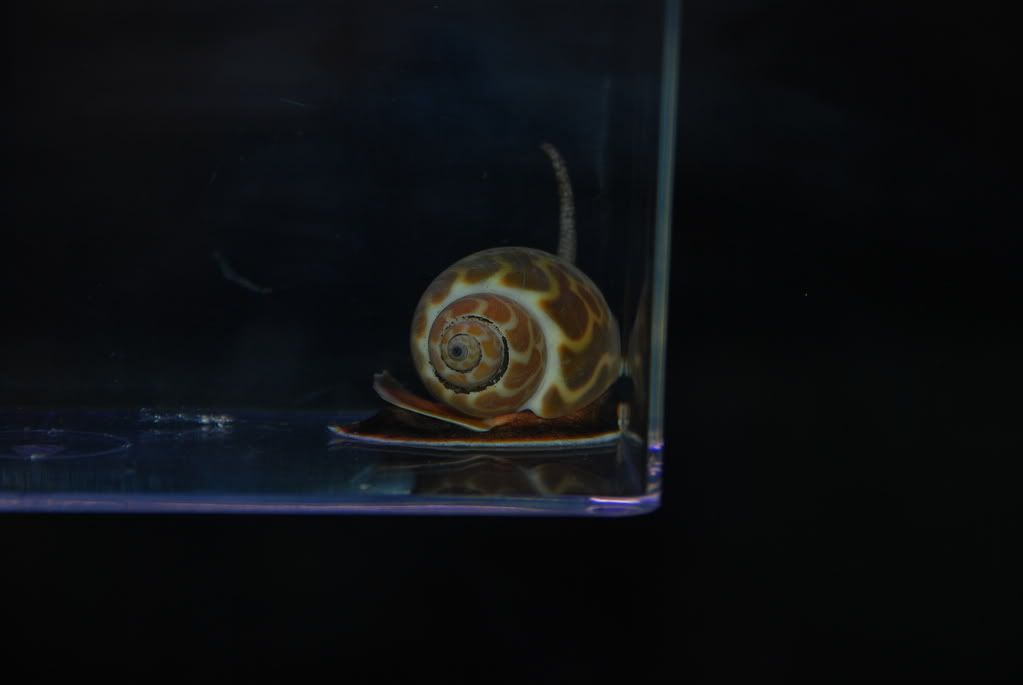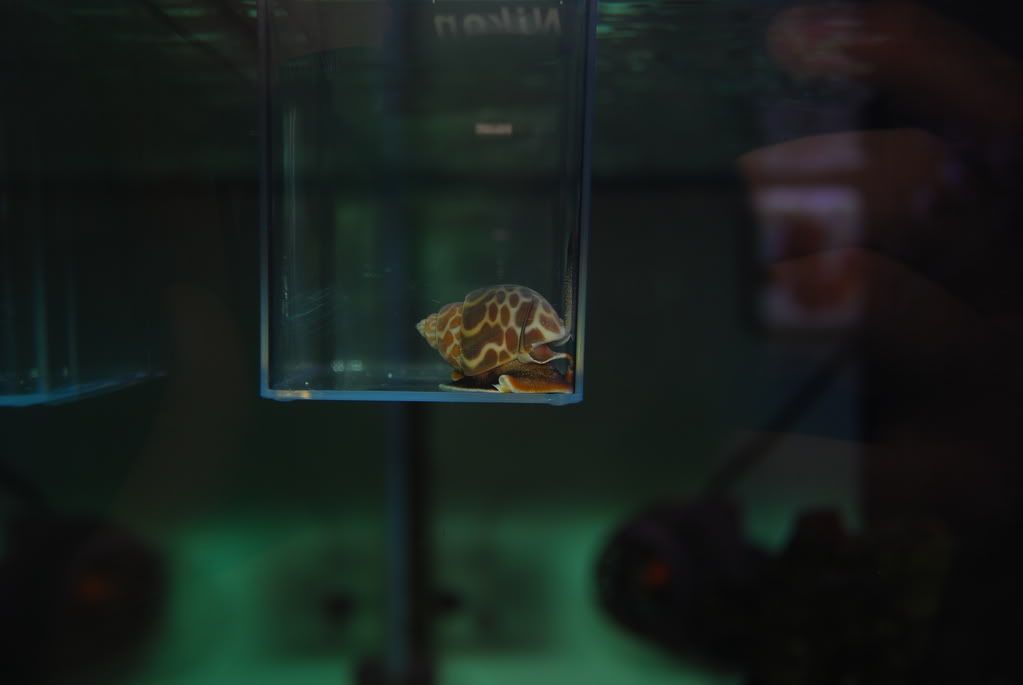


|
 |
|
|
#1 |
|
Registered Member
Join Date: Jul 2007
Location: California - South Bay Area
Posts: 2,775
|
I just got this from LFS and they called it a tongan nassarius. It looks cool and is bigger than my other nassarius. I just want to make sure it is not a whelk. How can I tell for sure?
 
|
|
|

|
|
|
#2 |
|
Registered Member
Join Date: Jan 2008
Location: LI,NY
Posts: 722
|
Not Tonga Nassarius, who has white flesh with a green spot and two burr's on its tail end.
__________________
I wasn't planning on keeping the turtle until it could pull me around under water. ~RV7AFlyer Current Tank Info: 150 ish gallons of Reef |
|
|

|
|
|
#3 |
|
Registered Member
Join Date: Jul 2007
Location: California - South Bay Area
Posts: 2,775
|
Online I have seen them as Orange Spotted Snail (Nassarius sp.) and as Turbo Grazer Snail (orange spot). But those are at obscure sites that don't give the full scientific name or tell anything about them.
|
|
|

|
|
|
#4 |
|
Registered Member
Join Date: Dec 2007
Location: Fredericksburg, VA
Posts: 298
|
It doesn't have the shell shape of a whelk.
__________________
"The sea, once it casts it's spell, holds one in its net of wonder forever."-Jacques Cousteau Current Tank Info: 150gal mixed reef |
|
|

|
|
|
#5 |
|
Registered Member
Join Date: Jul 2007
Location: California - South Bay Area
Posts: 2,775
|
I put it in my tank and it immediately buried itself in the sand. I just want to make sure this is completely reef safe.
|
|
|

|
|
|
#6 | |
|
Registered Member
Join Date: Jul 2007
Location: California - South Bay Area
Posts: 2,775
|
Quote:
|
|
|
|

|
|
|
#7 |
|
Registered Member
Join Date: Jul 2007
Location: California - South Bay Area
Posts: 2,775
|
The closest nassarius I could find is the Nassarius (Zeuxis) comptus, but I don't think that is it.
|
|
|

|
|
|
#8 |
|
Team RC Member
 Join Date: Feb 2007
Location: Conroe, TX
Posts: 2,761
|
I've answered several threads about these guys in the last week or two. It's a Babylonia species, probably Babylonia spirata. Babylonia species were lumped under the family Buccinidae, with the whelks, until fairly recently, but they've been reclassified into their own family, Babyloniidae, in the superfamily Muricoidea (with the Murexes). They are scavengers as well as predators, and are capable of killing other snails and bivalves in your tank, including tridacnids. If you keep them well fed, they may not bother to attack the other animals in your tank, but they might. They are beautiful animals, but you definitely don't want to keep them in a tank with your four baby Tridacna maxima clams, or any other clams, for that matter.
http://www.gastropods.com/0/Shell_10.html Cheers, Don |
|
|

|
|
|
#9 | |
|
Registered Member
Join Date: Jul 2007
Location: Ohio
Posts: 707
|
Thanks for the information on those. I have a half dozen of them that were sold to me as nassarius. They are very active scavengers, but I did loose a 2in maxima clam for no explainable reason 2 weeks after I got it, so maybe I know why now.
Quote:
|
|
|
|

|
|
|
#10 | |
|
Registered Member
Join Date: Jul 2007
Location: California - South Bay Area
Posts: 2,775
|
Quote:
I don't have any clams and am not planning on having any in the near future. Still, I think I will bring it back for fear that it may kill my other snails. Also, I wouldn't want it to reproduce in my tank and become a problem(not sure how likely that is). They are beautiful creatures. |
|
|
|

|
|
|
#11 |
|
Registered Member
Join Date: Oct 2007
Posts: 138
|
I have always heard them called Tiger Nassarius, we got them in once in a while at the store I worked at, and they are completely reef safe and wouldn't harm a clam unless it was already dying. They do the work of about 3 normal nassarius but cost from 3 to 5 times as much.
|
|
|

|
|
|
#12 | |
|
Team RC Member
 Join Date: Feb 2007
Location: Conroe, TX
Posts: 2,761
|
Quote:
Cheers, Don |
|
|
|

|
|
|
#13 |
|
Registered Member
Join Date: Jul 2007
Location: California - South Bay Area
Posts: 2,775
|
I have seen several posts by pagojoe regarding snails. He really knows his stuff. It is obviously a Babylonia whelk. He even supplied the link to show it. Here is another link that shows this snail as Not Reef Safe (scroll down to the Not Reef Safe section):
http://home2.pacific.net.ph/~sweetyu...tchsnails.html |
|
|

|
|
|
#14 |
|
Registered Member
Join Date: Jul 2007
Location: California - South Bay Area
Posts: 2,775
|
I just got off the phone with the LFS. They said that they bought it as a tongan nassarius and that they can only give partial credit since it was sold. It did not take much convincing to make them give me full credit, but I find it strange that they were resistant in the first place. They are usually pretty good about things regarding customer relations. Imagine if I did not find this out and I actually had clams for to kill. They should be thanking me for preventing future issues with clients. I guess they had to try

|
|
|

|
|
|
#15 |
|
Registered Member
Join Date: May 2005
Location: Indianapolis IN
Posts: 405
|
These were sold to me at a local maricultural facility as a giant nassarius. They are reef safe. I've had mine for about 6 months. They burrow in the sand and only come out from time to time. I have had no problems with mine. My only dislike is their size. They love mysis and krill!
|
|
|

|
|
|
#16 |
|
Registered Member
Join Date: Oct 2007
Posts: 138
|
I think that Pagojoe is right on this one....what store did you by them from?
|
|
|

|
|
|
#17 |
|
Registered Member
Join Date: May 2005
Location: Indianapolis IN
Posts: 405
|
This is interesting. Some of us are saying they are not reef safe some say they are. Not to start an all out war here, but I have some florida rock with turkey wing mollusk and my snails have not touched them. I would think they would considering they are just inches away from the sandbed. However, I did have a whelk that was removed prior to purchasing the "tiger nassarius, giant nassarius or one of the other names mentioned. The whelk killed two of the turkey wing mollusk and some of my other snails, such as cerith and nerite. I personally observed this. I have not noticed this with my giant nassarius (name sold to me).
I do not have any tridacnid clams at the moment, but have been thinking about getting one. I'm only commenting on my own observations and experiences within the last 6 months. |
|
|

|
|
|
#18 |
|
Team RC Member
 Join Date: Feb 2007
Location: Conroe, TX
Posts: 2,761
|
Well guys, after me telling you all how easy it would be to find the references of predation by Babylonia species, I've spent the last two hours trying to duplicate my searches and haven't found them either. As I remember it, one was a paper with Japanese authors, or maybe just researchers in Okinawa, regarding aquaculture of Tridacna species, and a small side note mentioned Babylonia species predating on them. There were at least two other anecdotal reports of Babylonia species killing molluscs in reef tanks, and I haven't located those either. I need to learn to mark my references, I suppose. If anyone finds those references again, please post them here.
Cheers, Don |
|
|

|
|
|
#19 |
|
Registered Member
Join Date: Jul 2004
Location: Puerto Rico
Posts: 1,278
|
__________________
"If the facts don't fit the theory, change the facts." A.E. Current Tank Info: 75 G BB tank |
|
|

|
|
|
#20 |
|
Registered Member
Join Date: Jul 2007
Location: California - South Bay Area
Posts: 2,775
|
I returned mine and the LFS said they called their supplier and told them what it was. The LFS was apologetic, but apparently the supplier did not really care too much. While I was there I bought a coral
 I don't know if I would consider it "Not Reef Safe." Just that it should not be kept with clams. So maybe "Reef Safe With Caution." As for the possibility of killing snails, they are probably safer than hermit crabs in this regard (but I don't keep hermits either) 
|
|
|

|
|
|
#21 |
|
Team RC Member
 Join Date: Feb 2007
Location: Conroe, TX
Posts: 2,761
|
Thanks for helping me look, gman. That's not exactly the one, although the wording is pretty close. I'm working the midnight shift tonight, so I had a few extra hours to read up on the Babylonia snails. It seems that most of the sources consider them to be primarily scavengers, and some only imply they may be predators. A few sources actually call them predatory, and interestingly enough, some of the species of Nassarius also get listed as occasional predators. I suppose "primarily scavenger" is probably good enough for most people with reef tanks, although the "occasional predator" part might cause some heartaches. I also learned that Babylonia snails produce a toxin that inhibits nicotinic receptors, although I'm not sure whether that is defensive or if it might be used to help capture prey, as in the Bursidae. It's been an educational thread.
Cheers, Don |
|
|

|
|
|
#22 |
|
Registered Member
Join Date: May 2005
Location: Fullerton, CA
Posts: 209
|
The Babylonia Whelk are NOT reef safe and I wish that LFS would stop selling them. I once made the mistake of buying a few little Babylonia Whelks thinking they were Nassarius. They look very similar when they are small, except for the leopard like pattern. These predatory snails killed several of my sand dwelling creatures. Their predation increased when I didn't feed the tank for a while. They move very fast. They are little killing machines and turn from scavengers into reef predators when there is not enough detritus to distract them. Do not buy these! They are good only for one thing, to produce shells for a tropical souvenir shop.
|
|
|

|
 |
|
|